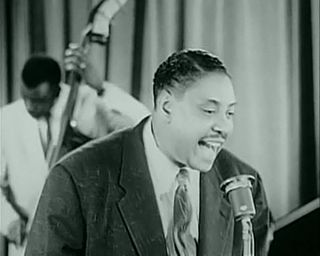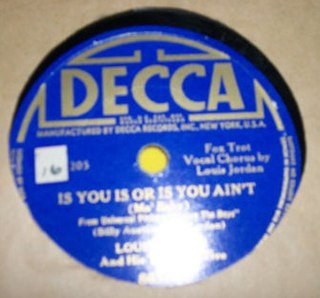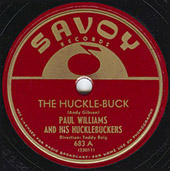
Rhythm and blues, frequently abbreviated as R&B or R'n'B, is a genre of popular music that originated within African-American communities in the 1940s. The term was originally used by record companies to describe recordings marketed predominantly to African Americans, at a time when "rocking, jazz based music ... [with a] heavy, insistent beat" was becoming more popular. In the commercial rhythm and blues music typical of the 1950s through the 1970s, the bands usually consisted of a piano, one or two guitars, bass, drums, one or more saxophones, and sometimes background vocalists. R&B lyrical themes often encapsulate the African-American history and experience of pain and the quest for freedom and joy, as well as triumphs and failures in terms of societal racism, oppression, relationships, economics, and aspirations.

Wynonie Harris was an American blues shouter best remembered as a singer of upbeat songs, featuring humorous, often ribald lyrics. He had fifteen Top 10 hits between 1946 and 1952. Harris is attributed by many music scholars to be one of the founding fathers of rock and roll. His "Good Rocking Tonight" is mentioned at least as a precursor to rock and roll.

Myron Carlton "Tiny" Bradshaw was an American jazz and rhythm and blues bandleader, singer, composer, pianist, and drummer. His biggest hit was "Well Oh Well" in 1950, and the following year he recorded "The Train Kept A-Rollin'", a song that was pivotal to the development of rock and roll. Bradshaw co-wrote and sang on both records.
Paul "Hucklebuck" Williams was an American jazz and blues saxophonist, bandleader, and songwriter. His record "The Huckle-Buck", recorded in December 1948, was one of the most successful R&B records of the time. In his Honkers and Shouters, Arnold Shaw credited Williams as one of the first to employ the honking tenor saxophone solo that became the hallmark of rhythm and blues and rock and roll in the 1950s and early 1960s.

Benjamin Clarence "Bull Moose" Jackson was an American blues and rhythm-and-blues singer and saxophonist, who was most successful in the late 1940s. He is considered a performer of dirty blues because of the suggestive nature of some of his songs, such as "I Want a Bowlegged Woman" and "Big Ten Inch Record".

Lucius Venable "Lucky" Millinder was an American swing and rhythm-and-blues bandleader. Although he could not read or write music, did not play an instrument and rarely sang, his showmanship and musical taste made his bands successful. His group was said to have been the greatest big band to play rhythm and blues, and gave work to a number of musicians who later became influential at the dawn of the rock and roll era. He was inducted into the Alabama Jazz Hall of Fame in 1986.

James Witherspoon was an American jump blues singer.

David Louis Bartholomew was an American musician, bandleader, composer, arranger, and record producer. He was prominent in the music of New Orleans throughout the second half of the 20th century. Originally a trumpeter, he was active in many musical genres, including rhythm and blues, big band, swing music, rock and roll, New Orleans jazz, and Dixieland. In his induction into the Rock and Roll Hall of Fame, he was cited as a key figure in the transition from jump blues and swing to R&B and as "one of the Crescent City's greatest musicians and a true pioneer in the rock and roll revolution".
"I Almost Lost My Mind" is a popular song written by Ivory Joe Hunter and published in 1950. Hunter's recording of the song was a number one hit on the US Billboard R&B singles chart in that year.

"Good Rocking Tonight" is a jump blues song originally released in 1947 by its writer, Roy Brown and was covered by many recording artists. The song includes the memorable refrain, "Well I heard the news, there's good rocking tonight!" The song anticipated elements of rock and roll music.

"Is You Is or Is You Ain't My Baby" is a song written by Louis Jordan and Billy Austin. The song's first recording, by Jordan, was made on October 4, 1943. It was released as the B-side of a single with "G.I. Jive" with the title "Is You Is or Is You Ain't ". The song reached No. 1 on the US folk/country charts, number two for three weeks on the pop chart, and number three on the R&B chart.
The Hot R&B/Hip-Hop Songs chart ranks the most popular R&B and hip hop songs in the United States and is published weekly by Billboard. Rankings are based on a measure of radio airplay, sales data, and streaming activity. The chart had 100 positions but was shortened to 50 positions in October 2012.

William Wright was an American singer. He is considered one of Little Richard's greatest influences in his formative years.
Margie Day, later Margie Day Walker, was an American R&B singer who had success in the 1950s and 1960s.
Herbert J. Lance was an American jazz, blues and gospel singer, songwriter, record producer, recording studio owner and radio DJ. As well as recording several hits himself in the late 1940s, he co-wrote Ruth Brown's signature song, "Mama, He Treats Your Daughter Mean".

Theodore Samuel Reig was a self-described "jazz hustler" who worked as a record producer, A&R man, promoter, and artist manager from the 1940s through the 1970s. As a record producer, he captured the work of dozens of jazz innovators. He also influenced rhythm and blues, rock and roll, and Latin music.
Velma "Chubby" Newsom or Newsome was an American R&B singer who performed and recorded in the 1940s and 1950s.

The Huckle-Buck and Robbins' Nest is an album by trumpeter Buck Clayton which was recorded in 1953 and released on the Columbia label.
"Now's the Time" is a composition by Charlie Parker. He led the first recording of it, on November 26, 1945.













